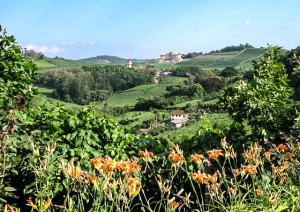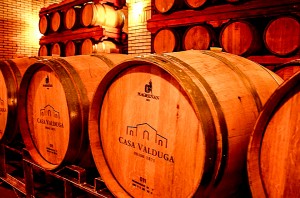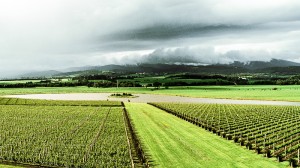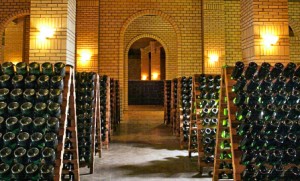Like most of the world, we’re experiencing world cup fever, and this past weekend was our first chance to actually entertain around it! While we’ve been sneakily watching the matches here and there, we finally had two solid days where we could get together with friends, hook up a TV outside, and bask in the sunshine and soccer (sorry, we mean football). And since you know we love any excuse to drink wine, we couldn’t help but pop one great Brazilian wine open with plenty of great reasons to it.
 Since Brazil is famous for many things; carnival, Copacabana beach and football (obviously) to name just three and wine isn’t normally the first thing people think of when they think of Brazil. But wine is produced in the country and one region in particular, the Vale dos Vinhedos (Valley of the Vineyards) is probably the best known of all in the country, having had its mark left there in the mid-1850’s by the Italian immigrants who originally settled there. It is the only region in the country to receive official recognition (kind of like AOC in Bordeaux or DOC in Italy) when the region was recognized, first in 2002 with a seal of Indication of Origin and again more recently in 2011 with a seal of Designation of Origin. However, wine production and consumption in Brazil overall can be traced back to the mid-1500’s when Portuguese settlers and Jesuit priests planted vines in the area around Sao Paolo.
Since Brazil is famous for many things; carnival, Copacabana beach and football (obviously) to name just three and wine isn’t normally the first thing people think of when they think of Brazil. But wine is produced in the country and one region in particular, the Vale dos Vinhedos (Valley of the Vineyards) is probably the best known of all in the country, having had its mark left there in the mid-1850’s by the Italian immigrants who originally settled there. It is the only region in the country to receive official recognition (kind of like AOC in Bordeaux or DOC in Italy) when the region was recognized, first in 2002 with a seal of Indication of Origin and again more recently in 2011 with a seal of Designation of Origin. However, wine production and consumption in Brazil overall can be traced back to the mid-1500’s when Portuguese settlers and Jesuit priests planted vines in the area around Sao Paolo.
 In recent years, Brazil has begun to export some stellar wine, catching up to fellow South American countries Argentina and Chile, and is now the third largest wine producer in the region. Currently Cabernet Sauvignon represents the most planted grape varietal in the country, but other well-known French grapes such as Merlot and Chardonnay are also gaining ground and being used to make great wines.
In recent years, Brazil has begun to export some stellar wine, catching up to fellow South American countries Argentina and Chile, and is now the third largest wine producer in the region. Currently Cabernet Sauvignon represents the most planted grape varietal in the country, but other well-known French grapes such as Merlot and Chardonnay are also gaining ground and being used to make great wines.
Chances are that wherever you may be, you’ll be drinking your normal tipple, be it lager, real ale, craft beer, spirits, wine, water, Caipirinha, orange juice, or whatever. However, for those of us not living in South America, Brazilian wine may be a completely novel concept. How many people know that there is such a thing? Well, if you’re planning to immerse yourself, quite literally, in the spirit of the occasion, then why not enjoy a taste of the country that is hosting this football spectacular and have a glass or two of ‘vinho do Brazil’? It’s time to wake up the Brazilian in you and enjoy!
 So far, Brazil has won the football World Cup a record five times. No other country can match this and the country is unsurprisingly among the favorites to lift the trophy once again. However, well before this competition was invented, the Brazil had been producing wine, beginning and not quite succeeding in the 16th Century, before being resurrected by Jesuit priests for religious purposes in the 17th Century. The big turning point came at the start of the 19th century, when the Portuguese royal family lifted a previously enforced ban on winemaking and over the next 200 years, European influences have helped shape and modernize the country’s wine industry. It is now the fifth largest wine producer in the southern hemisphere with 1,162 wineries and a yearly output of 330 million liters, according to Wines of Brazil.
So far, Brazil has won the football World Cup a record five times. No other country can match this and the country is unsurprisingly among the favorites to lift the trophy once again. However, well before this competition was invented, the Brazil had been producing wine, beginning and not quite succeeding in the 16th Century, before being resurrected by Jesuit priests for religious purposes in the 17th Century. The big turning point came at the start of the 19th century, when the Portuguese royal family lifted a previously enforced ban on winemaking and over the next 200 years, European influences have helped shape and modernize the country’s wine industry. It is now the fifth largest wine producer in the southern hemisphere with 1,162 wineries and a yearly output of 330 million liters, according to Wines of Brazil.
 Sparkling wines are a real speciality of Brazil, in particular lower alcohol versions made from Moscato. Both the traditional and Charmat methods are used in the production of sparkling wine, but the combination of misty mornings, hot days and cool nights is particularly good for Pinot Noir and Chardonnay, so traditional method sparklers made from these grape varieties are also popular.
Sparkling wines are a real speciality of Brazil, in particular lower alcohol versions made from Moscato. Both the traditional and Charmat methods are used in the production of sparkling wine, but the combination of misty mornings, hot days and cool nights is particularly good for Pinot Noir and Chardonnay, so traditional method sparklers made from these grape varieties are also popular.
OK, so you’re going to watch the World Cup with friends at home and you’d like to have some wines to suit the mood, the occasion and to offer an alternative source of alcoholic imbibement for non-beer drinkers. Given that you may want to drink more than one glass, it makes sense to drink a lighter style of wine and a relatively low alcohol Moscato would be a good, thirst-quenching, summer-time option while watching both the football and, as every fan knows, the even more important pre- and post-match analysis. There are many excellent, complex and heavier style wines which would suit a serious meal, but I want to focus more on good quality, lighter wines, which might just stop your guests from tripping over the dog.
Spurred on by the World Cup, but with the Olympics also on the horizon, the appeal of Brazilian wine fits in with a more adventurous outlook on food and drink generally in the UK. Let’s hope the football is equally adventurous and may the best team win!
Do you want to learn more about Brazilian wines? Check our wine map!



 0
0